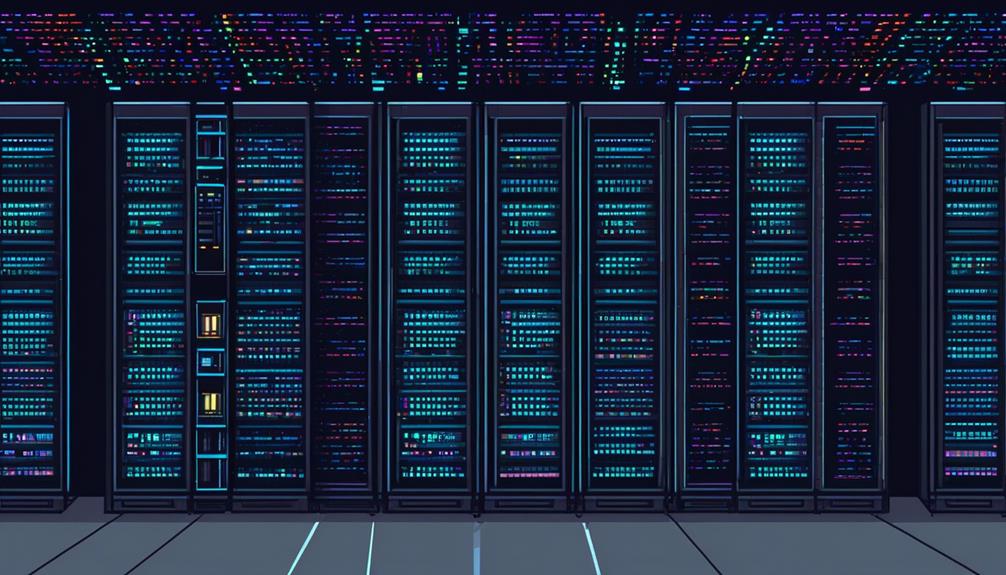With the exponential growth of data-intensive applications and the need for efficient resource utilization, high-density data center infrastructure has become a critical consideration for organizations.
The ability to handle increased rack densities is not only essential for scalability and competitiveness but also for reducing energy consumption.
However, managing high-density data centers comes with its own set of challenges, from efficient cooling and space utilization to power requirements and security considerations.
In this discussion, we will explore the solutions, emerging technologies, and best practices for designing and implementing high-density data centers.
By delving into these topics, we will uncover the key factors that contribute to the success and optimization of high-density data center infrastructure, leaving you intrigued and eager to explore further.
Key Takeaways
- Efficient cooling is crucial for high-density data centers to ensure optimal performance, reliability, and longevity of the infrastructure.
- Implementing efficient rack layouts and maximizing space utilization are essential in high-density data centers to make the most of available space.
- Security measures, such as physical access control and surveillance systems, are important to protect sensitive data in high-density data centers.
- Emerging technologies like liquid cooling solutions and advanced power distribution technologies are being utilized to address cooling and power demands while improving energy efficiency and handling higher power densities.
Challenges of High-Density Data Center Infrastructure
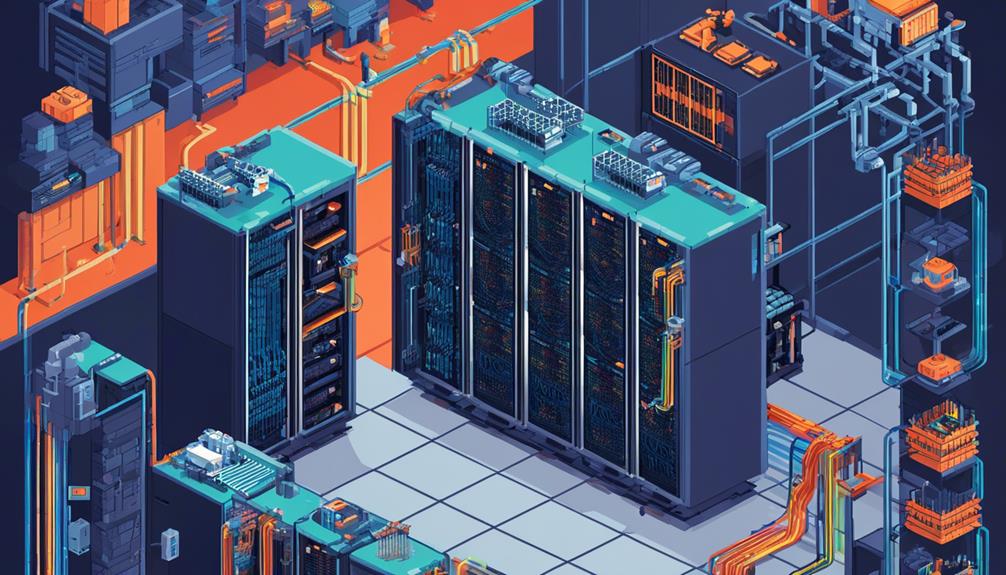
What are the challenges that arise when dealing with high-density data center infrastructure?
High-density data centers, characterized by their high power density and increased heat load, present unique challenges in terms of power demands and cooling technologies. The higher rack densities in these data centers require efficient cooling systems that can handle the increased heat load. Managing airflow becomes critical to prevent hot spots and ensure proper cooling throughout the facility.
One of the main challenges of high-density data center infrastructure is the need for additional power and cooling infrastructure upgrades. Higher rack densities often require more power to support the increased number of servers and equipment. Ensuring proper power distribution and redundancy is crucial to support the higher rack densities and prevent power outages that could lead to downtime and data loss.
Another challenge is the selection and implementation of suitable cooling technologies. Traditionally, air cooling has been the primary method used in data centers. However, with the rise of high-density data centers, advanced cooling technologies such as liquid cooling are becoming increasingly popular. Liquid cooling allows for higher rack densities by efficiently removing heat from the server rack, reducing the risk of overheating.
Solutions for Managing High-Density Data Centers
When it comes to managing high-density data centers, two key points to consider are cooling techniques and power management strategies.
Cooling techniques play a crucial role in maintaining optimal temperature levels in these densely packed environments, preventing equipment overheating and ensuring reliable performance.
Power management strategies are also essential, as high-density setups require sufficient power supply and distribution to support the increased demands of the equipment.
Implementing effective cooling techniques and power management strategies are vital components of successfully managing high-density data centers.
Cooling Techniques for High-Density Data Centers
Liquid cooling and immersion cooling are effective solutions for managing the heat generation and cooling challenges in high-density data centers. Traditional cooling methods may not be suitable for high-density data centers due to space constraints and complex infrastructure requirements. In these environments, high density racks are utilized to maximize server density, resulting in increased power and cooling demands.
Liquid cooling techniques involve circulating coolants directly through the servers, effectively removing heat at the source. This method can significantly improve cooling efficiency and reduce overall energy consumption.
Immersion cooling, on the other hand, involves submerging the servers in a dielectric fluid, which absorbs and dissipates heat. This technique eliminates the need for complex airflow management and allows for higher rack densities.
Power Management Strategies
Power management strategies are crucial for optimizing energy usage and reducing costs in high-density data centers. With the increasing demands for computing power and the adoption of technologies like AI and ML, data centers are becoming denser, requiring efficient power management solutions.
Monitoring and managing power and cooling infrastructure in real-time is essential for proactive optimization and efficiency. Utilizing advanced cooling technologies, such as liquid cooling and immersion cooling, can effectively handle the heat generated by high-density setups. These cooling techniques help maintain optimal temperatures, ensuring the reliability and performance of the data center while reducing the energy consumption.
Importance of Efficient Cooling in High-Density Data Centers
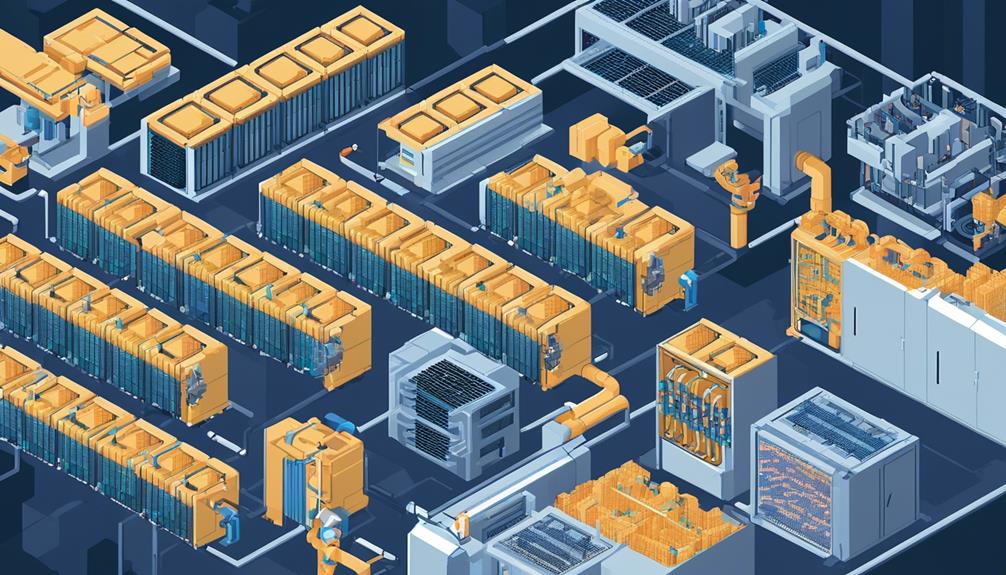
Efficient cooling is a critical component in high-density data centers. It ensures optimal performance, reliability, and longevity of the infrastructure. High-density data centers consolidate a large number of servers and equipment in a limited space, resulting in a significant amount of heat generation. Without efficient cooling methods, the increased heat levels can lead to overheating, which can degrade the performance and reliability of the infrastructure.
Proper cooling in high-density data centers helps to maintain a consistent and stable operating environment necessary for the seamless operation of critical applications and services. Cooling methods such as precision air conditioning, hot and cold aisle containment, and liquid cooling solutions are employed to effectively manage and dissipate the substantial heat generated by densely packed servers and equipment.
Efficient cooling not only ensures the reliability of the infrastructure but also contributes to energy savings and cost reduction. By implementing advanced cooling strategies, high-density data centers can minimize power consumption associated with cooling, aligning with sustainability and operational efficiency goals. Additionally, effective cooling solutions help to reduce the risk of downtime due to overheating, ensuring uninterrupted operation and minimizing the potential for data loss or service disruption.
Optimizing Space Utilization in High-Density Data Centers
What strategies can be implemented to optimize space utilization in high-density data centers?
Optimizing space utilization in high-density data centers is crucial for maximizing efficiency and reducing costs. With the increasing demand for storage and the need to handle large amounts of data, it is essential to make the most of the available space.
Here are three strategies that can be implemented to optimize space utilization in high-density data centers:
- Implement efficient rack layouts: Designing the rack layout properly is essential for space optimization. By carefully arranging the racks, it is possible to maximize the use of the available space. Consider factors such as airflow, accessibility, and cable management when planning the layout. Utilize techniques like hot aisle containment and cold aisle containment to improve airflow and reduce energy consumption.
- Utilize high-density equipment: High-density data centers require the use of high-density equipment to make the most of the available space. Switching to high-density racks and servers allows for a greater number of computing resources within a smaller footprint. This helps in increasing the overall data center density and optimizing space utilization.
- Consolidate and virtualize: Consolidating servers and virtualizing applications can significantly reduce the physical footprint of a data center. By running multiple virtual machines on a single physical server, it is possible to achieve higher server utilization and reduce the number of physical servers required. This consolidation and virtualization strategy can help optimize space utilization in high-density data centers.
Power Requirements and Considerations for High-Density Data Centers
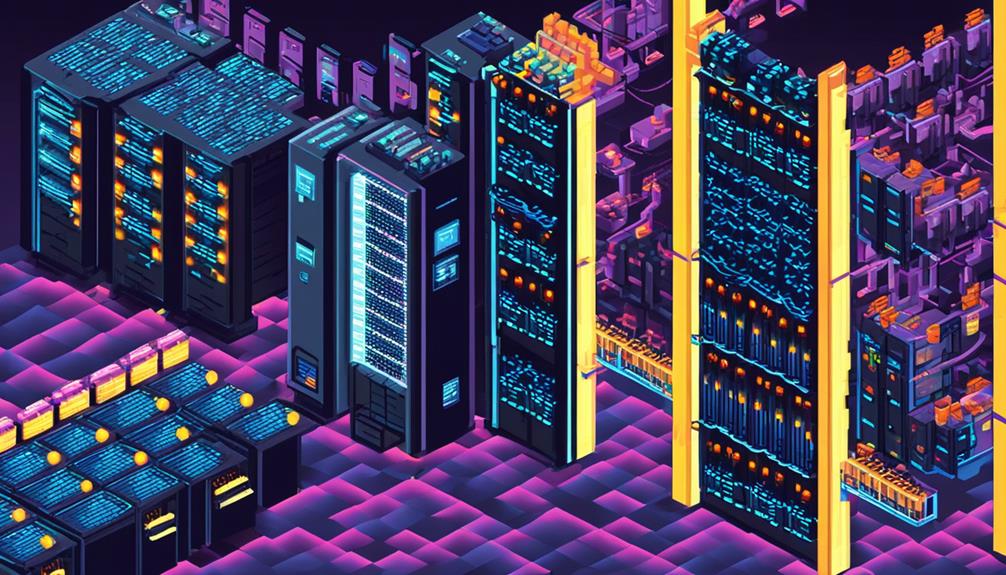
In high-density data centers, the efficient management of power requirements and considerations is essential to handle the increased heat generation and power densities associated with heavier cabinets and advanced computing workloads. High-density data center infrastructure demands specialized power requirements and considerations to ensure reliable and uninterrupted operations.
One of the primary considerations for high-density data centers is the need for increased power supply. As the power densities increase, data center operators must ensure that sufficient power is available to support the servers and networking equipment. This may involve upgrading the electrical infrastructure, such as transformers and switchgear, to handle the higher power demands.
Another critical consideration is the cooling infrastructure. Higher power densities result in increased heat generation, requiring specialized cooling equipment to dissipate the heat effectively. Traditional cooling methods may not be sufficient to handle the heat produced by high-density data centers. Data center operators need to consider alternative cooling technologies, such as liquid cooling and immersion cooling, to address the heat challenges associated with high-density computing environments.
Airflow management is also crucial in high-density data centers. Proper airflow design and management ensure that cool air is efficiently delivered to the equipment and hot air is effectively exhausted. This can be achieved through the use of hot-aisle/cold-aisle containment systems, optimized rack layouts, and strategic placement of cooling equipment.
As technology continues to advance and high-performance computing workloads, AI, and machine learning become more prevalent, the power demands for high-density data centers are expected to increase further. To support these higher rack densities, data center operators must stay updated with the latest power requirements and considerations, as well as continually evaluate and invest in efficient power and cooling infrastructure solutions.
Scalability and Flexibility in High-Density Data Center Infrastructure
As high-density data centers continue to evolve and accommodate the increasing power demands and heat generation, the focus now shifts towards discussing the crucial aspects of scalability and flexibility in their infrastructure.
Scalability and flexibility are essential components of high-density data center infrastructure, enabling data centers to meet the growing compute power and cooling capacity requirements.
Here are three key considerations for achieving scalability and flexibility in high-density data center infrastructure:
- Modular Design: Adopting a modular design approach allows data centers to easily scale their infrastructure as needed. By using standardized building blocks, such as pre-configured racks and power distribution units (PDUs), data centers can efficiently add or remove capacity without disrupting ongoing operations. This modular approach also simplifies maintenance and upgrades, reducing downtime and maximizing uptime.
- Flexible Cooling Solutions: High-density data centers generate more heat, necessitating advanced cooling solutions. Implementing flexible cooling solutions, such as hot aisle containment or liquid cooling, enables efficient heat dissipation and ensures the optimal operating temperature for equipment. These solutions can be tailored to specific rack densities, ensuring effective cooling while minimizing energy consumption and costs.
- Virtualization and Automation: Virtualization technologies, such as server virtualization and software-defined networking, enable data centers to optimize resource allocation and improve overall efficiency. By consolidating multiple virtual machines onto fewer physical servers, data centers can increase compute power while reducing the physical footprint. Automation further enhances scalability and flexibility by streamlining routine tasks and enabling rapid provisioning and deployment of new resources.
Security and Risk Management in High-Density Data Centers
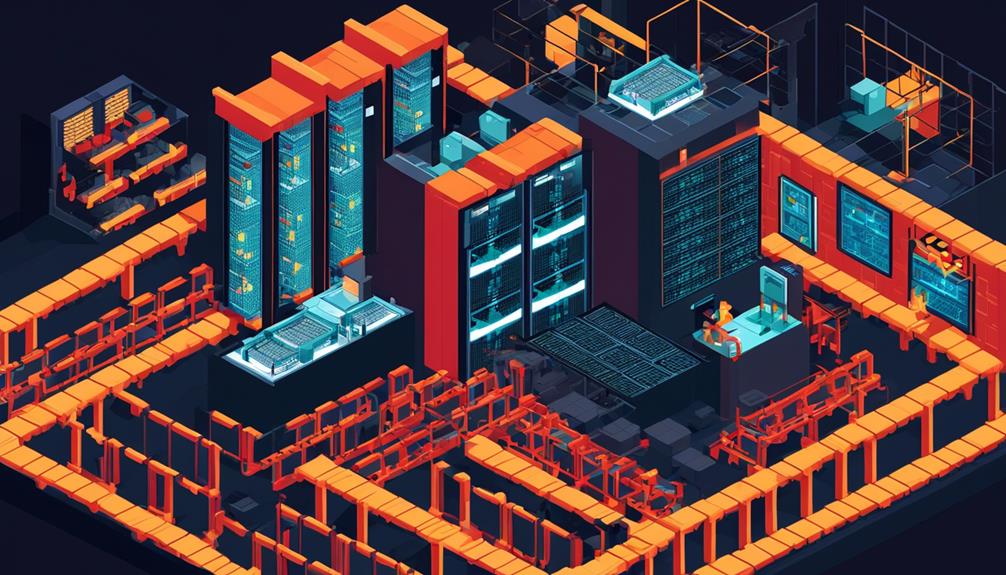
Security and risk management in high-density data centers require the implementation of robust physical access control measures and threat detection systems.
Physical access control ensures that only authorized personnel can enter the data center facility, reducing the risk of unauthorized access or tampering with sensitive equipment.
Threat detection systems such as intrusion detection and video surveillance help monitor and identify potential security breaches, allowing for timely response and mitigation of risks.
Physical Access Control
Effective physical access control is a critical component in ensuring the security and risk management of high-density data centers. To protect valuable data and prevent unauthorized entry, data centers employ various physical access control measures. Here are three commonly used methods:
- Biometric authentication: Biometric systems, such as fingerprint or iris scanners, offer a high level of security by uniquely identifying individuals based on their physiological characteristics.
- Key card access: Key card systems use electronic credentials to grant or deny access to data center facilities. This provides a convenient and traceable method for managing entry permissions.
- Surveillance systems: Video surveillance cameras monitor and record activities within the data center. They act as a deterrent and aid in identifying any security breaches that may occur.
Threat Detection Systems
To ensure the security and risk management of high-density data centers, the implementation of threat detection systems is crucial. These systems utilize advanced technologies to monitor and analyze network traffic, identifying anomalies and detecting potential security breaches in real-time. By employing machine learning and artificial intelligence algorithms, threat detection systems continuously assess and mitigate security risks.
They integrate threat intelligence feeds and leverage behavior analysis to proactively identify and address potential security vulnerabilities and attacks. The implementation of these systems is essential for maintaining the security and integrity of high-density data center environments, protecting sensitive data, and ensuring operational continuity.
Threat detection systems play a vital role in safeguarding the high-density data center infrastructure from potential threats and security risks.
Emerging Technologies for High-Density Data Center Infrastructure
The rapid development of emerging technologies is revolutionizing the infrastructure of high-density data centers. As the demand for high-performance computing (HPC), artificial intelligence, and machine learning increases, data centers must adapt to accommodate the growing power and cooling requirements.
Here are three emerging technologies that are shaping the future of high-density data center infrastructure:
- Liquid Cooling Solutions: To address the challenges of cooling high-density setups, liquid cooling solutions are gaining popularity. These innovative technologies use liquid to transfer heat away from the servers more efficiently than traditional air cooling methods. By directly cooling the components, liquid cooling can significantly reduce power consumption and improve overall energy efficiency. Additionally, liquid cooling can help data centers achieve higher power densities without compromising performance or reliability.
- Advanced Power Distribution: With the increasing power demands of high-density data centers, advanced power distribution technologies are essential. These technologies focus on optimizing power delivery, reducing energy losses, and improving overall power efficiency. Intelligent power distribution units (PDUs) equipped with monitoring and management capabilities allow data center operators to track power usage, identify potential issues, and optimize power distribution to maximize efficiency and minimize downtime.
- AI-Driven Infrastructure Management: The complexity of high-density data centers requires intelligent infrastructure management solutions. Artificial intelligence (AI) and machine learning algorithms can analyze vast amounts of data in real-time, enabling predictive analytics, proactive maintenance, and intelligent resource allocation. AI-driven infrastructure management systems can optimize power usage, identify potential bottlenecks, and make data-driven decisions to enhance performance, improve energy efficiency, and reduce operational costs.
Best Practices for Designing and Implementing High-Density Data Centers
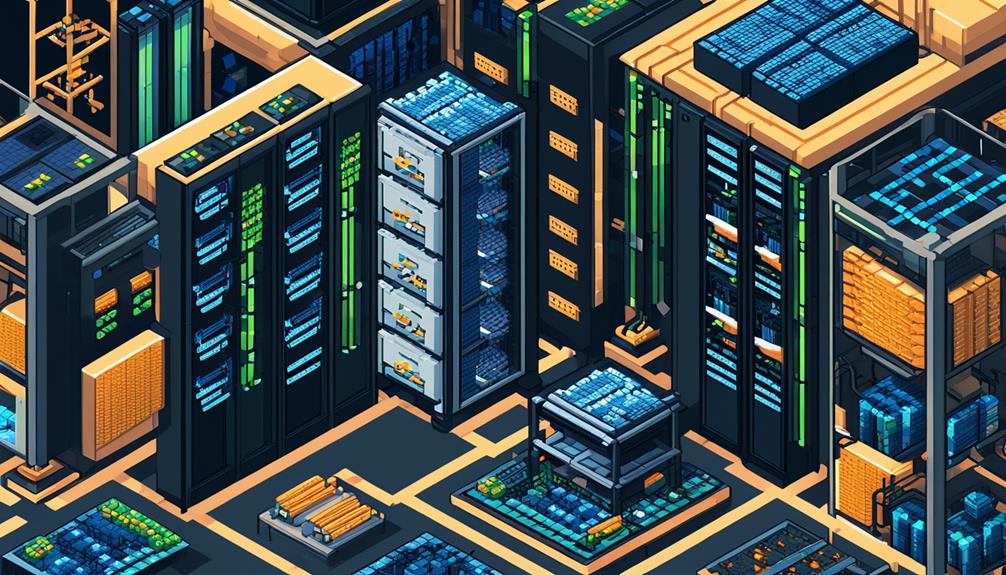
As high-performance computing (HPC), artificial intelligence, and machine learning continue to drive the demand for high-density data centers, it is imperative to implement best practices that ensure efficient and effective design and implementation. Designing and implementing high-density data centers require careful planning and consideration of various factors such as power supply, cooling, and space constraints. By following best practices, data centers can optimize their infrastructure to handle the increasing amount of data being generated and provide efficient and cost-effective storage solutions.
One of the key considerations when designing high-density data centers is power supply. High-density setups require additional power to support the increased number of servers and equipment. Implementing redundant power supplies and backup generators is crucial to ensure uninterrupted operations and prevent downtime. It is also important to consider power distribution and load balancing to distribute power evenly across the data center.
Cooling is another critical aspect of high-density data center design. The increased heat generated by high-density servers requires efficient cooling mechanisms to prevent overheating and ensure optimal performance. Traditional cooling equipment may have limited space in high-density setups, making it necessary to explore alternative cooling solutions such as liquid cooling or hot aisle/cold aisle containment systems.
Space optimization is also essential for high-density data centers. With the denser equipment and heavier cabinets, it is important to ensure that the data center's physical infrastructure can support the weight and provide adequate space for equipment installation and maintenance. Proper cable management and rack layout can help maximize space utilization and improve airflow for efficient cooling.
In summary, designing and implementing high-density data centers require careful consideration of power supply, cooling, and space optimization. By following best practices, data centers can ensure efficient and effective operations, handle the increasing data demands, and remain competitive in the ever-evolving technology landscape.
| Best Practices for High-Density Data Centers | ||
|---|---|---|
| Power Supply | Cooling | Space Optimization |
| Implement redundant power supplies and backup generators. | Explore alternative cooling solutions such as liquid cooling or containment systems. | Maximize space utilization and improve airflow through proper cable management and rack layout. |
| Distribute power evenly and ensure load balancing. | Prevent overheating and ensure optimal performance. | Ensure the physical infrastructure can support the weight and provide adequate space for equipment installation and maintenance. |
Frequently Asked Questions
What Is High-Density Data Center?
A high-density data center refers to a facility that maximizes the use of space by implementing efficient cooling solutions and power requirements. This setup allows for optimal space utilization and the ability to house a large number of server racks in a limited area.
High density cooling is essential to prevent overheating of the equipment and maintain optimum performance.
What Are the 3 Main Components of a Data Center Infrastructure?
The three main components of a data center infrastructure are computing hardware, networking equipment, and storage devices.
Computing hardware includes servers, mainframes, and specialized processors for high-performance computing tasks.
Networking equipment encompasses routers, switches, and firewalls that enable communication and data transfer within the data center and to external networks.
Storage devices consist of hard drives, solid-state drives, and tape libraries for storing and managing data.
These components are crucial for the scalability, power efficiency, cooling solutions, network infrastructure, and physical security of a data center.
What Are the Four Main Types of Data Centers?
There are four main types of data centers:
- Enterprise data centers, which are owned and operated by individual companies.
- Managed services data centers, which are managed by third-party providers.
- Colocation data centers, which are shared facilities where multiple organizations rent space.
- Cloud data centers, which are operated by cloud service providers.
Each type of data center serves different purposes and caters to varying needs in terms of IT infrastructure, storage, and computing resources.
What Are the Five Core Elements of the Data Center Infrastructure?
Data center design encompasses the five core elements of a data center infrastructure: cooling solutions, power management, network infrastructure, scalability, and flexibility.
Cooling solutions are crucial for maintaining optimal operating temperatures, while efficient power management ensures uninterrupted power supply.
Network infrastructure involves the hardware and software components that enable data transportation.
Scalability enables data centers to accommodate increasing workloads, and flexibility allows for easy adaptation to changing business needs.
These elements form the foundation of a well-designed data center infrastructure.
